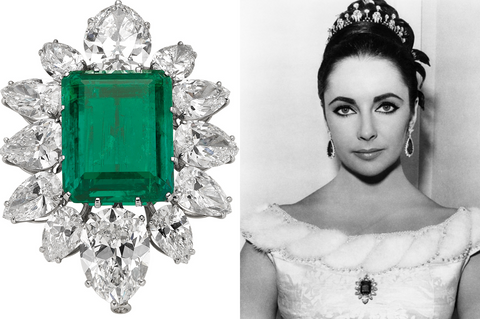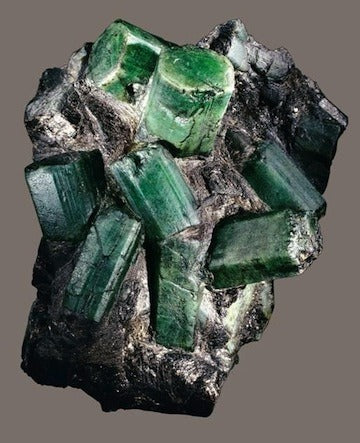Your Top 10 Emerald Questions, Answered
Class is back in session, this time it’s all about the alluring, mythical gemstone… emerald.
What are Emeralds?
They are one of our favourite gemstones (don’t tell diamonds).
Emeralds are naturally occurring gemstones and are a part of the beryl mineral family. When beryl comes into contact with trace amounts of the chemicals chromium and on occasion, vanadium, it colours the beryl a lush deep green, creating what we have come to know as emeralds. Other well-known beryl gemstones include morganite and aquamarine.
Where Does the Word Emerald Come From?
The history of the word emerald is rooted in Ancient Greek. It originates from the Greek word, smaragdos, quite literally translating to emerald.
What are Inclusions in Emeralds?
Inclusions are naturally formed inside emeralds when gas, liquid, or solid components become trapped within the stone. Inclusions can appear like tiny bubbles in champagne or moss fragments. Finding emeralds that do not have visible inclusions is extremely rare, and becoming less sought after as inclusions make each emerald unique and beautiful.
Inclusions can also be specific to location, which makes inclusions valuable for evaluating an emerald’s geography, authenticity, and value.
How Soft are Emeralds?
They’re sensitive, but not exactly soft. Contrary to popular belief, emeralds aren’t categorised as a ‘soft stone’. Emeralds are ranked 7.5-8 out of 10, on the MOHS scale of mineral hardness. They aren’t the hardest gemstone (that one goes to diamonds), but they certainly aren’t the softest. Inclusions, particularly surface inclusions, are what tend to make an emerald soft.
Don’t let emeralds’ apparent softness alarm or scare you away from picking an emerald for any piece of jewellery. A skilled jeweller should be able to maintain the integrity of the stone and set it safely for everyday wear.
Can You Wear Emeralds Every Day?
Absolutely! Emeralds, when treated with and set with care by expert jewellers, are set for life. We are quite fond of a bezel setting for our emeralds, encasing the gemstone in solid gold for longevity, resilience, and safety.
Emeralds are, however, sensitive to heat, particularly to drastic changes in temperature. We would recommend being wary of wearing emeralds during certain daily activities such as washing dishes in hot water, or washing your hands and then drying them under a hot hand dryer. Drastic changes in temperature can cause tension on the inclusions within an emerald, which could cause an emerald to crack.
Always be mindful of your jewellery (its claws, chain, setting, and band) coming into regular contact with harsh chemicals. Chlorine and strong cleaning products can damage or discolour your solid gold and platinum settings when exposed on a regular and long-term basis.
How and Where do Emeralds Commonly Form?
Emeralds, as a naturally occurring mineral, form within the surface layers of the earth. Scientists believe it may take up to 100,000 years for emeralds to form.
Emeralds form in two ways. The first involves their formation within pegmatite rock, which occurs after magma has cooled. If the pegmatite rock contains beryllium, chromium, and/or vanadium, the resulting minerals, become emeralds and acquire their distinctive green hue. Alternatively, emeralds can also form within hydrothermal veins. In this process, hydrothermal fluids escape from the Earth's magma core, cool down, and mix with the same minerals and chemicals to create emeralds.
Currently, Colombia is the world's main producer of emeralds. Colombian mines produce between 70% to 90% of emeralds worldwide, followed by Zambia.
Emeralds or Diamonds?
Don’t make us choose! Diamonds and emeralds both have unique qualities, historical symbolisms, and are available in an abundance of cuts, designs, and settings. At the end of the day, diamonds and emeralds are both rare, incomparable stones. It is all about what matters most to you and what works best with your lifestyle. Any stone that can naturally form looking that beautiful is a favourite of ours!
If you can’t decide, why not try both? We’ll help!
If you’re still not sure, you can learn more about Diamonds in our Diamond 101 blog!
Are Emeralds More Expensive than Diamonds?
It all depends. Generally, if an emerald and a diamond are of equal quality, the emerald will be more expensive. This is not due to any difference in quality, it is simply because emeralds are rarer than diamonds.
However, grading or comparing emeralds and diamonds is relatively subjective as they do not have equal gradings or certifications, like the 4Cs for example. A diamond can be cut specifically for light refraction, yet an emerald is unique as its green glow or luminescence is undetermined by its cut.
What do Emeralds Symbolise?
Emeralds are not only the May birthstone or the stone for Gemini and Taurus birthdates of the Western Zodiac, but arguably the stone of the ancient world. Emeralds have captivated cultures for centuries, ancient and modern, across history from Ancient Greeks to Romans, Egyptians, and Incas.
In Ancient Greece, Aphrodite, Goddess of Love and Beauty, was known to adorn emeralds for their eternal power in love. Emeralds were commonplace in shrines to Aphrodite, an offering in hopes to be blessed with love and fertility. Outside of mythology, the famous Greek philosopher Aristotle noted the stone’s power to give presence and aid in speech, as well as its ability to provide clarity in eyesight. Aristotle’s notes may have encouraged the practice of crushing emeralds into dust, to be used in eye lotion.
The Ancient Egyptians are known to have been the first to mine emeralds dating back to 330 BC in Egypt, eventually owned by Cleopatra herself. The Egyptian Queen wore the emeralds as conduits of fertility and rebirth, which may be why many Egyptians were buried with the stone.
Emeralds have been symbolic and played a core role in many ancient cultures. However, emeralds are well-known as symbols of eternal love, foresight, fortune, and nobility, in the 21st century.
What are the Most Famous Emeralds in History?
Emeralds are loved for many reasons, but a special few are incredible enough to make their mark on history.
The Chalk Emerald

Source: Smithsonian Gem Gallery
The Chalk Emerald, weighing 37.8 carats, was set in gold and platinum by jewellery designer, Harry Winston, who surrounded the stone with sixty pear shape diamonds. The ring, weighing over 50cts, is on display in the Gem Gallery at the Smithsonian in Washington.
Elizabeth Taylor’s Engagement Brooch

Source: Lifestyle Asia
Elizabeth Taylor’s emerald collection is one of the most famous in history. The pièce de résistance of her collection is her rumoured ‘engagement brooch’, given to her by her Cleopatra co-star, Richard Burton. The ‘engagement brooch’ was not only unconventional as it was not an engagement ring, but because the brooch was also an attachment to a diamond and emerald necklace (which the pair later acquired). Taylor never admitted that the brooch was in fact an ‘engagement brooch’, as she was married to singer Eddie Fisher at the time, but it’s almost certain it marked the couple's engagement.
The brooch featuring an emerald cut Colombian emerald surrounded by twelve pear shape diamonds, weighs approximately 23.46 carats and holds the current record for the most expensive piece of jewellery sold at auction, selling for over $6.5 million dollars.
The Bahia Emerald

Source: Wikipedia
The largest emerald ever found is the Bahia Emerald. The unfaceted, shards of emerald crystals, mined in Bahia, Brazil, weigh approximately 381 kilograms, coming to an estimated carat weight of 180,000 carats. The Bahia Emerald has been appraised at $400 million dollars, yet its true value is unclear.
From their formation deep within the Earth to their association with eternal love and rebirth, emeralds have intrigued cultures for centuries. Whether you’re captivated by their alluring green glow or fascinated by their historical significance, emeralds hold a place as one of the most cherished gemstones in the world of fine jewellery for a reason.
If you’re as captivated by emeralds as us, you’re going to love our everything emerald collection.
















